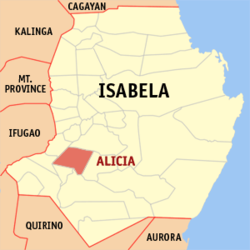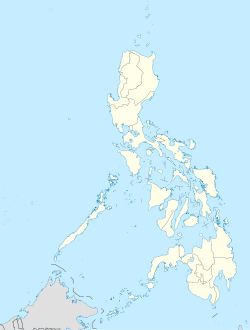- Alicia, Isabela
-
Alicia — Municipality — Map of Isabela showing the location of Alicia. Location in the Philippines Coordinates: 16°47′N 121°42′E / 16.783°N 121.7°ECoordinates: 16°47′N 121°42′E / 16.783°N 121.7°E Country  Philippines
PhilippinesRegion Cagayan Valley (Region II) Province Isabela District 3rd District, Isabela Founded Barangays 34 Government – Mayor Cecilia Claire N. Reyes Area – Total 154.10 km2 (59.5 sq mi) Population (2007) – Total 61,447 – Density 398.7/km2 (1,032.8/sq mi) Time zone PST (UTC+8) ZIP code 3306 Income class 2nd class; rural Population Census of Alicia Census Pop. Rate 1995 52,666 — 2000 57,178 1.78% 2007 61,447 1.00% Alicia (a.k.a. Angadanan Viejo) is a 2nd class municipality in the province of Isabela, Philippines. According to the 2007 census, it has a population of 61,447 people in 11,413 households.
The town sits on a vast area of predominantly flat and fertile land in the Cagayan Valley that surrounded by the Caraballo Mountains to the south, the Great Sierra Madre to the east and the Cordillera Mountain Range to the west. It is the largest rice producer in the entire Cagayan Valley and has the largest irrigated rice field in the whole Region II of the Philippines.
Alicia, the old town of Angadanan, is known for the Pagay Festival and its famous historical landmark, the Our Lady of Atocha Church completed and inaugurated in 1849 which was officially declared by the Philippine Department of Tourism as one of the national religious tourist destinations in the Philippines.
Contents
History
Alicia was once called "Angadanan Viejo" (which means – Old Angadanan) when the new Angadanan was relocated in 1776 to its current location near the Angadanan Creek.[1]
The old Angadanan town was part of the Cagayan Valley province. The entire Cagayan Valley was one large province which the Spaniards called La Provincia del Valle de Cagayan, but divided into two new provinces in 1839 by the Spanish conquistadors. One retained the old name Cagayan which comprised all towns from Aparri to Tumauini; while a new province of Nueva Vizcaya was created composed of all towns from Ilagan to the Caraballo del Sur including Catalangan, Angadanan (now Alicia), and Palanan, with Camarag (Echague) as its capital.[2]
A Royal Decree was created on May 1, 1856 creating Isabela de Luzon to distinguish it from other Isabelas in the Philippines. It comprised the town of Carig (now Santiago City), Camarag (now Echague), Angadanan (now Alicia), Cauayan, Calanusian (now Reina Mercedes), Gamu, and Ilagan, all detached from Nueva Vizcaya; while Tumauini and Cabagan were taken from the Cagayan province. It was placed under the jurisdiction of a governor with the capital seat at Ilagan, where it remains at the present.[2]
When the late Philippine President Elpidio Quirino signed Executive Order No. 268 on September 28, 1949, the Old Angadanan was renamed and created the municipality of Alicia in honor of then Quirino’s wife, Dona Alicia Syquia Quirino, who was murdered by the Japanese during the Japanese occupation.[3]
Tourist attractions
Our Lady of Atocha Church
The Our Lady of Atocha Church in Alicia is noted for having an old Spanish church. It is one of the best churches to visit for a pilgrimage in the Philippines during the Holy Week.[4] The church was declared by the Philippine Department of Tourism as one of the national religious tourist attractions in the Philippines.
The structure of the church was original built by the Spaniards in the 18th century, but not finished. Passing by Angadanan town on February 12, 1805, Fr. Manuel Mora, OP wrote that “Angadanan has a convent of bricks, though not totally finished. Its church is timber, wood, and bamboo. The number of inhabitants is 791.” The church and convent as seen today in the town of Alicia, beautiful and solid, was built by Fr. Tomas Calderon, OP and inaugurated in 1849, with Fr. Francisco Gainza, OP, then vicar of Carig (now Santiago City). The church was dedicated to the Nuestra Señora de Atocha, more popularly known today as Our Lady of Atocha. The church is known for its antique Castilian architectural design and can be found along the Maharlika Highway and is accessible by land transport.[2][5][6]
The Catholic churches in Alicia, Gamu, and Cauayan City, are examples of what is called as the "Cagayan Style" of Spanish churches that was inspired by the Tuguegarao church.
Pagay Festival
The "Pagay Festival" is held annually every 28th of September in conjunction with the founding anniversary of the town of Alicia. It used to be called Alicia Town Festival, but was redefined and renamed to Pagay Festival in 2010 by Mayor Cecilia Claire N. Reyes.
The festival aims to uphold the town's cultural identity and heritage and to promote the municipality’s primary agricultural product called, pagay (Ilocano word for rice)- the municipality’s major livelihood economy and trade mark.[7]
The festival is widely participated by the community which features various competitions (e.g., rice planting, harvesting, and cooking among others), street dance showdown, beauty pageant (Mutya ng Alicia), battle of the bands, and exhibits. However, the Pagay Parade is the main highlight of the festival that features decorated carabaos, various rice crop floats, and people marching with colorful costumes which attracts tourists and visitors.
Barangays
Alicia has a total land area of 15, 410 hectares and 64, 339 total population as of 2009. 71% of the total land area is an agricultural land which makes Alicia primarily an agricultural municipality best suited for the intensive production of rice and corn. Farming is its major livelihood and rice its major product and resource. Alicia is politically subdivided into 34 barangays:
- Amistad
- Antonino (Pob.)
- Apanay
- Aurora
- Bagnos
- Bagong Sikat
- Bantug-Petines
- Bonifacio
- Burgos
- Calaocan (Pob.)
- Callao
- Dagupan
- Inanama
- Linglingay
- M.H. del Pilar
- Mabini
- Magsaysay (Pob.)
- Mataas na Kahoy
- Paddad
- Rizal
- Rizaluna
- Salvacion
- San Antonio (Pob.)
- San Fernando
- San Francisco
- San Juan
- San Pablo
- San Pedro
- Santa Cruz
- Santa Maria
- Santo Domingo
- Santo Tomas
- Victoria
- Zamora
Dialect
The population is a combination of different ethnic group dominated by Ilocano speaking people which make Ilocano the common dialect used in the municipality.
List of mayors
The first mayor (municipality leader) of Alicia was Glicerio Acosta who was appointed to office by the President of the Philippines upon the creation of Alicia as a municipality in 1949.
The current mayor for the 2010–2013 term is Cecilia Claire N. Reyes, who won in the 2010 election. The mayor is restricted to three consecutive terms, totaling nine years, although a mayor can be elected again after an interruption of one term.
The following is the chronological list of current and past mayors of Alicia:
Number Name Tenure 10. Cecilia Claire N. Reyes 9. Napoleon S. Dy 8. Manuel A. Alejandro 7. Norberta C. Agustin 6. Ramon M. Reyes 5. Federico M. Abuan Sr. 4. Lorenzo M. Dasig Sr. 3. Marcelino Dacanay 2. Celedonio B. Magbaleta 1. Glicerio Acosta Educational institutions
Alicia has two universities that cater to the people of the municipality and other neighboring municipalities and provinces. It has a number of public elementary schools, two private and four public high schools.
College and University
- Adventist University of the Philippines (Nela Campus)
- Philippine Normal University- Isabela branch
High School
Private Schools
- Adventist University of the Philippines (Nela Campus)
- Dalton Academy
- School of Our Lady of Atocha
- St. John Adaptive Montessori School
- Top Achievers Private School
- Odizee School of Achievers
Public Schools
- Alicia Vocational School
- Alicia National High School
- Palayan Region High School
- Rizal Region National High School , Alicia, Isabela
Elementary School
Private Schools
- Alicia Adventist Multigrade School
- Faith Christian Academy
- School of Our Lady of Atocha
- St. Francis School Foundation
- St. John Adaptive Montessori School
- Top Achievers Private School
Public Schools
- Alicia Central School
- Alicia North Central School
- Alicia West Central School
- Amistad Elementary School
- Apanay Public School
- Aurora Elementary School
- Bagnos Elementary School
- Bagong Sikat Elementary School
- Bantug Petines Elementary School
- Bonifacio Elementary School
- Burgos Elementary School
- Callao Elementary School
- Dagupan Elementary School
- Inanama Elementary School
- Linglingay Elementary School
- Mabini Elementary School
- Mataas na Kahoy Elementary School
- MH del Pilar Elementary School
- Paddad Elementary School
- Rizal Elementary School
- Rizaluna Elementary School
- Salvacion Elementary School
- San Antonio Elementary School
- San Fernando Elementary School
- San Francisco Elementary School
- San Juan Elementary School
- San Pablo Elementary School
- San Pedro Elementary School
- Sta. Cruz Elementary School
- Sta. Maria Elementary School
- Sto. Domingo Elementary School
- Sto. Tomas Elementary School
- Victoria Elementary School
- Zamora Elementary School
External links
- Alicia, Isabela official website
- Philippine Standard Geographic Code
- 1995 Philippine Census Information
- 2000 Philippine Census Information
- 2007 Philippine Census Information
- Our Lady of Atocha Colonial Church
References
- ^ "Things to Do and see in Isabela". http://www.da-isabela.com/history.html. Retrieved 2008-01-19.
- ^ a b c "Isabela Travel Information". http://www.flyphilippines.com.ph/isabela/info.html. Retrieved 2010-01-16.
- ^ "Isabela History". Archived from the original on July 18, 2011. http://web.archive.org/web/20110718080331/http://www.wowphilippines.com.ph/explore_phil/place_details.asp?content=thingstodo&province=6. Retrieved 2008-01-19.
- ^ Martinez-Clemente, Jo (23 April 2011). ela&cd=14&hl=en&ct=clnk&gl=us&source=www.google.com "Relic of Christ’s cross a must for Visita Iglesia". Inquirer.net Philippine Daily Inquirer. http://webcache.googleusercontent.com/search?q=cache:9DIJgQ619jIJ:globalnation.inquirer.net/region/philippines/view/20110423-332623/Relic-of-Christs-cross-a-must-for-Visita-Iglesia+our+lady+of+atocha+church+isab ela&cd=14&hl=en&ct=clnk&gl=us&source=www.google.com. Retrieved 17 June 2011.
- ^ Rumpon, Danijay. "Province of Isabela Tourists Attractions and Destinations". Cagayan Valley Region. dotregion2.com.ph. http://www.dotregion2.com.ph/d2/index.php?option=com_content&view=article&id=66&Itemid=78. Retrieved 17 June 2011.
- ^ "Tourists Attractions". MyPhilippines.com The Ultimate Travel Guide for Tourists. Department of Tourism (Philippines). http://www.visitmyphilippines.com/index.php?title=Isabela&func=all&pid=1020&tbl=0. Retrieved 17 June 2011.
- ^ "PAGAY FESTIVAL". Philippine Tourism. Philippine Department of Tourism. http://www.tourism.gov.ph/sitepages/FestivitiesList.aspx?festivityCode=1062&monthCode=09. Retrieved 17 June 2011.
Municipalities - Alicia
- Angadanan
- Aurora
- Benito Soliven
- Burgos
- Cabagan
- Cabatuan
- Cordon
- Delfin Albano
- Dinapigue
- Divilacan
- Echague
- Gamu
- Ilagan
- Jones
- Luna
- Maconacon
- Mallig
- Naguilian
- Palanan
- Quezon
- Quirino
- Ramon
- Reina Mercedes
- Roxas
- San Agustin
- San Guillermo
- San Isidro
- San Manuel
- San Mariano
- San Mateo
- San Pablo
- Santa Maria
- Santo Tomas
- Tumauini
Component city - Cauayan
Independent component city - Santiago
Categories:- Municipalities of Isabela
Wikimedia Foundation. 2010.


